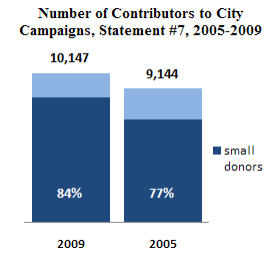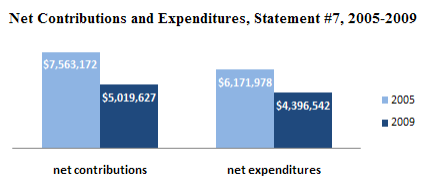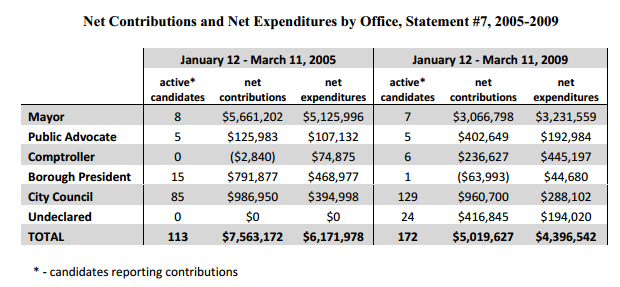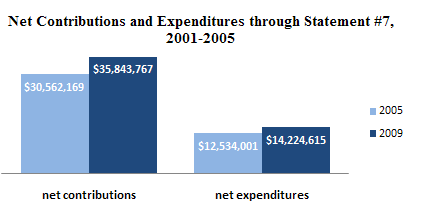April 13, 2009
With the 2009 election year now underway, candidate fundraising
continues to proceed at a slower pace than in previous election cycles. Candidates
reported raising substantially less money during the two months ended March 11, 2009
than during the same two-month period in 2005, the year of the last citywide elections.
While recent fundraising has slowed, the overall story of the 2009 election cycle is quite
different. Candidates in the 2009 elections have still out-raised their 2005 counterparts
since the start of the four-year election cycle. Campaigns are relying on a broader base of
contributors than in past elections, and are gathering support from small donors in greater
proportions than ever before. “The growing involvement of small donors in the 2009
City elections is one of the real positive stories of the campaign so far,” said Amy
Loprest, Executive Director of the CFB. “With those small donations creating
opportunities to receive matching funds through the Campaign Finance Program, more
candidates should have the resources to run competitive campaigns.”
NUMBER OF INDIVIDUAL AND SMALL DONATIONS CONTINUES TO RISE
While overall fundraising has slowed, the number of contributors is up. A central goal of
the Campaign Finance Program is to encourage more New York City residents to become
active in the political process, amplifying the impact of their small contributions by
matching them with public funds. The data show that campaigns are collecting fewer dollars, but growing numbers of donors. Small donations (under $250) to City candidates have increased as well. Between January 12 and March 11, 2009, a total of 10,147 contributors gave to candidates; of those, 84 percent gave $250 or less. During the comparable period in 2005, only 9,144 contributors gave to candidates; 77 percent of those were small donors.
The final phase of new limits on contributions from those “doing business” with City government was implemented on November 30, 2008. Principal owners, executives, and senior managers of entities involved in contracts, franchises, concessions, grants, pension investment agreements, economic development agreements, real property transactions, or land use actions may contribute no more than $400 to a candidate for mayor, $320 to a candidate for borough president, and $250 to a candidate for City Council. Registered lobbyists and bidders for contracts, franchises and concessions are similarly limited. The most recent disclosure statement filed with the CFB was the first for which those limits were in effect for the full range of “doing business” activities across the entire duration of the disclosure period. While the Board will conduct a thorough study of the effects of the “pay-to-play” reforms after the 2009 elections have concluded, the early data suggests they may be helping to renew candidates’ interest in reaching out to small donors.

FUNDRAISING AND SPENDING DIP; OVERALL LEVELS REMAIN HIGH
In terms of net contributions, fundraising during the two-month period concluded March
11 (Statement #7) represented a 34 percent drop-off from the similar period in 2005—
even though more candidates are active in 2009. Candidates raised $5.0 million over the
first two months of 2009, compared with $7.6 million during the first two months of
2005, the last citywide election year.

Spending activity overall for the two months ended March 11 lags behind the 2005 pace as well, but the trend is not consistent across all offices. Whilefundraising and spending among candidates for mayor, borough president and Council seems to have slowed, competitive races for public advocate and comptroller are driving an increase in spending among candidates for those citywide offices.
Though fundraising is down, the 2009 candidates are still ahead of the overall pace set in 2005. Candidates have raised $35,782,207during the first 38 months of the election cycle, compared with $30,562,169 overall through March 11, 2005—an increase of roughly 17 percent. Overall spending is up from 2005 levels at a similar proportion (see chart).

COUNCIL RACES HEAT UP
Another encouraging sign for this year’s elections is the increased number of candidates registered with the CFB. In addition to competitive races for the citywide offices, more candidates for City Council are preparing to run this fall than in 2005.
Though some speculated that the extension of term limits would discourage competition, especially at the City Council level, this does not seem to have been the case. There were 128 council candidates with contributions during the first two months of 2009, compared
with 85 in 2005. Another 24 active candidates have not declared an office with the CFB; many of those are likely to conduct campaigns for Council.
With 19 candidates submitting their initial registration with the CFB since the end of the last filing period, indications are that the 2009 elections will see more competition than in 2005.
There were a total of 163 candidates for Council on the ballot in the 2005 elections; 126
of them, more than three-fourths, participated in the Campaign Finance Program. The
deadline to join the Program for the 2009 election cycle is June 10.
This trend shows that the Campaign Finance Program is accomplishing its mission to
enable more citizens to compete for city office.
For more information or detail about campaign fundraising and spending, please visit the
CFB website’s financial summary page or the searchable campaign finance database.










